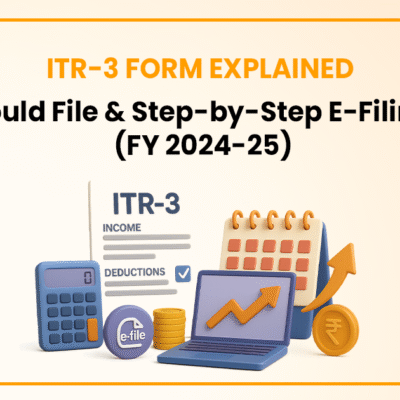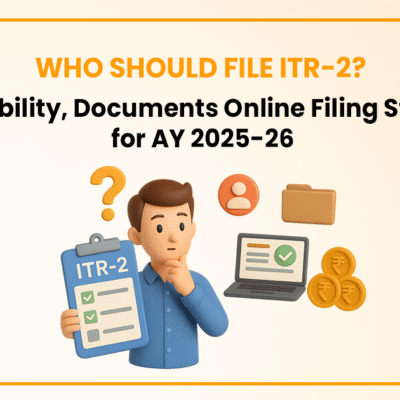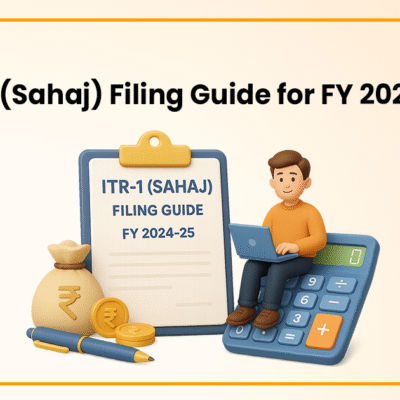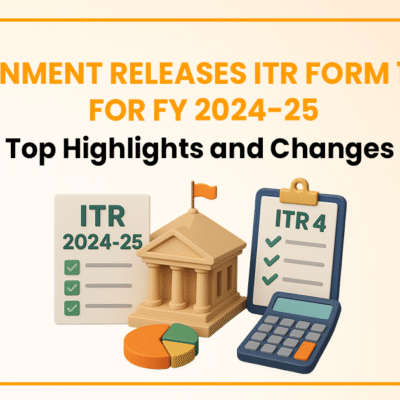Recent Updates regarding Income Tax Return and New Income Tax Return Forms
- February 18, 2023
- Income Tax

Filing Income Tax Returns (ITR) can be a daunting task for many individuals, especially those who are not familiar with the process. However, with the help of the new ITR forms and the recent changes, the process has become much simpler and hassle-free. The government has introduced several changes in the ITR forms to ensure that taxpayers can file their returns quickly and easily. In this article, we will discuss Recent Updates regarding Income Tax Return and New Income Tax Return Forms.
| Table of Content |
Key Abstract
Income Tax Laws are enacted by the Government of India. Individuals, Hindu Undivided Families (HUFs), Companies, Firms, Limited Liability Partnerships (LLP), associations of persons, bodies of individuals, local authorities, and any other artificial legal person are taxed. These laws regulate the levy of tax on a person based on his resident status. The Indian government recently announced a number of adjustments to the Income Tax Return (ITR) forms for fiscal year 2022-23. These modifications are intended to make the tax filing process easier and more effective for taxpayers.
Let us first look into the meaning of Income Tax Return, why everyone should file them, before we should move into the changes brought by the Indian Government.
Meaning of Income Tax Return
ITRs are a particular kind of form used by people to provide the Indian government with information about their income and taxes. ITRs are a particular kind of form that detail a person's earnings and the taxes that must be paid during the fiscal year (Starting from April 1 to March 31st next year).
Revenue can come in a variety of forms depending on the business, the job description, and other financial resources. Several forms of income exist:
- Salary, and;
- Revenue from additional sources
- Gain through a business endeavour
- Rental or revenue from a home
- Capital gain earnings.
- Other sources of revenue, such as royalties, interest on deposits, dividends, and so on.
Each person is required by the Income Tax Department to submit a separate ITR for each form of income. Depending on the kind and quantity of the taxpayer's annual income, there are seven distinct types of ITR Forms that must be completed, according to the Income Tax Department.
You can rely on Legal Window to give you all the services and legal counsel you need to file your Income Tax Returns and to help you with other compliances. For help submitting your Income Tax Return, contact our staff at 072407-51000 or [email protected].
Why should everybody file an Income Tax Return?
ITR filing demonstrates the sense of accountability among Indians. The government can only learn about its citizens' annual accounts and transactions through ITR, which helps to improve the nation's economic climate and create advanced action plans for the good of the nation.
Here are a few justifications for submitting your Income Tax Returns:
- Submitting tax returns is crucial in a number of situations and shows accountability.
- If you apply for a credit card or a loan, you will also require this information.
- You need ITR records if you wish to file a claim for compensation for prior losses.
- It will also be profitable and advantageous if the findings are updated.
Additionally, there are several advantages to filing an ITR, including the following:
- It Avoids Penalty: Submitting an ITR late has a cost! Indian Income Tax laws stipulate that failure to file an ITR by the deadline specified by the Income Tax Department may result in a fine of up to Rs 10,000.
- Carry forward your losses: To claim particular losses, such as losses from capital gains, losses from a business or profession, etc., individual taxpayers must timely file their Income Tax Returns. This suggests that you can reduce your future tax liability by deducting certain losses from the relevant income. Before the person submits a tax return, this cannot occur.
- Interest Saving: If an ITR is not submitted on time, interest may be added to the amount of tax due. If you submit your ITR on time, sections 234A and 234B allow you to avoid paying interest on overdue taxes. There is no penalty relief for ITR filings that are late.
- Easy Loan Approval: Submitting the ITR will help persons who are requesting a car loan, house loan, or other type of loan. Also, as confirmation of your income, all financial institutions may want to see a copy of your tax returns. For the loan to be accepted, this documentation must also be presented.
- Request a Tax Refund: In order to get a tax refund, most individual taxpayers with passive income, such as term deposit interest or dividend income, must file a tax return. Additionally, documentation must be filed even for salaried taxpayers who had too much tax withheld in order to get a refund for the overpayment.
Recent Updates regarding Income Tax Returns and New Income Tax Return Forms
The Indian government recently announced a number of modifications to the Income Tax Return (ITR) form for the fiscal year 2022-23. These modifications are intended to make the tax filing process easier and more effective for taxpayers. Submitting Income Tax Returns may be a difficult undertaking for many people, particularly those who are unfamiliar with the procedure. But, because of the new ITR forms and subsequent improvements, the procedure has become considerably easier and less time-consuming. The government has made various adjustments to the ITR forms to make it easier for taxpayers to complete their returns.
New ITR Forms
The new ITR forms for the financial year 2022-23 have been announced by the government. The forms have been made simpler, with a reduced number of fields to be filled by taxpayers. There are now seven ITR forms available, and each form caters to different types of taxpayers. Let's take a closer look at each form:
- ITR-1: This form is for individuals with income up to Rs. 50 lakh and who have income from salaries, one house property, and other sources.
- ITR-2: This form is for individuals and HUFs who have income from salaries, multiple house properties, capital gains, and other sources.
- ITR-3: This form is for individuals and HUFs who are partners in a partnership firm and have income from salaries, house properties, capital gains, and other sources.
- ITR-4: This form is for individuals, HUFs, and firms with a turnover of up to Rs. 2 crore, and who have income from business or profession.
- ITR-5: This form is for partnerships, LLPs, and associations of persons (AOPs).
- ITR-6: This form is for companies, except those claiming exemption under Section 11 of the Income Tax Act, 1961.
- ITR-7: This form is for persons including companies that are required to furnish return under Section 139(4A), 139(4B), 139(4C), and 139(4D) of the Income Tax Act, 1961.
Recent Changes regarding Income Tax Return
Taxpayers should be aware that there have been no substantial modifications to the ITR forms. Taxpayers will be relieved to learn that ITR-1 has not changed. A new schedule has been created under the heading of Capital Gains in the other remaining forms for reporting Income from Virtual Digital Assets. This new schedule requires taxpayers to record the date of purchase, date of transfer, cost of acquisition, and revenues received on VDA sales. VDA income must be disclosed quarterly.
The ITR forms have also been changed to contain extra questions concerning the new tax regime option. Taxpayers must now declare whether they opted for the new system in the preceding assessment year, as well as the assessment year in which they did so. Another question has been introduced, asking taxpayers to disclose if they opted out of the new system in any previous year, as well as supply the 10IE information for both options.
Apart from the new ITR forms, the government has also made some recent changes to the tax filing process. Here are some of the significant changes:
- Pre-filled ITR forms: The government has introduced pre-filled ITR forms to reduce the time taken by taxpayers to file their returns. The pre-filled forms will have details of the taxpayer's salary, tax payments, and TDS, among others.
- Aadhaar Authentication: The government has made it mandatory for taxpayers to authenticate their returns using Aadhaar. This will help in reducing the instances of fraudulent tax filings.
- Scrapping of tax refunds for non-filers: The government has decided to discontinue the practice of providing tax refunds to taxpayers who do not file their returns. This move is aimed at encouraging people to file their returns and stay compliant.
Takeaway
The new ITR forms and recent changes announced by the government are aimed at simplifying the tax filing process for individuals and businesses. The pre-filled forms and mandatory Aadhaar authentication will help in reducing errors and fraudulent tax filings. With the new ITR forms and recent changes, the government has taken a significant step toward making tax filing more accessible and efficient for taxpayers. It is essential to keep abreast of these changes to ensure that you file your tax returns correctly and on time.
Company Secretary and diligent learner deeply immersed in the world of corporate law, compliance, and governance with a focus on developing a robust foundation in legal principles and corporate practices. Passionate about exploring the intricacies of company law, regulatory compliance, and corporate governance.
Categories
- Agreement Drafting (23)
- Annual Compliance (13)
- Change in Business (37)
- Company Law (150)
- Compliance (90)
- Digital Banking (3)
- Drug License (4)
- FEMA (17)
- Finance Company (42)
- Foreign Taxation (9)
- FSSAI License/Registration (15)
- GST (124)
- Hallmark Registration (1)
- Income Tax (214)
- Latest News (36)
- Miscellaneous (170)
- NBFC Registration (8)
- NGO (18)
- SEBI Registration (6)
- Section 8 Company (10)
- Start and manage a business (27)
- Startup/ Registration (134)
- Trademark Registration/IPR (48)
Recent Posts
- Major Upgrade: Breaking Down GST 2.0 September 15, 2025
- New Income Tax Bill 2025 August 27, 2025
- ITR-3 Form Explained: Who Should File & Step-by-Step E-Filing Guide (FY 2024-25) June 25, 2025
All Website Tags
About us
LegalWindow.in is a professional technology driven platform of multidisciplined experts like CA/CS/Lawyers spanning with an aim to provide concrete solution to individuals, start-ups and other business organisation by maximising their growth at an affordable cost.









